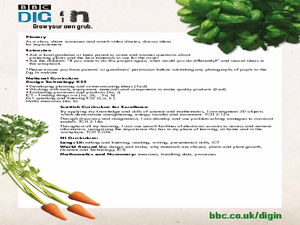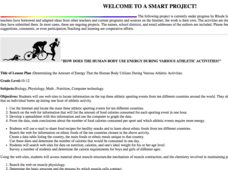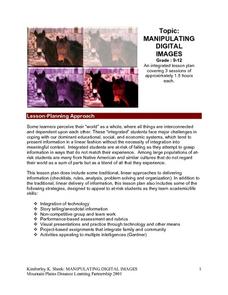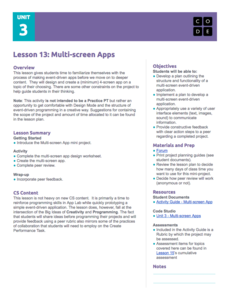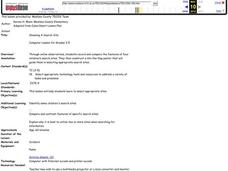Curated OER
Best lesson in the whole world!
Students study the concept of fraction using mathematical reasoning. In this problem solving fraction lesson, students use various methods to explain their reasoning in solving fractions. Students use a number of different prompts to...
Curated OER
Technology
Third graders play a game on the computer called "Last Array" where they practice their multiplication skills. In this multiplication lesson plan, 3rd graders try to be the last person to place an array on the computer screen.
Curated OER
Technology
Students create podcasts. In this technology lesson, students familiarize themselves with podcasts and develop their own podcast about a current event.
Curated OER
Technology - money
First graders trade coin amounts by using punch out coins. In this trading coins lesson plan, 1st graders use pennies, nickels, and dimes, and then trade them with each other in equivalent amounts. Students also complete money computer...
Curated OER
Technology: fractions
Sixth graders review equivalent fractions by using folded paper and shading in different amounts. In this fractions lesson plan, 6th graders review fractions with the paper, and then go onto internet sites to practice concepts on...
Curated OER
Design Technology- Grow Your Own Grub
Students design a protective cover for outdoor plants. In this agricultural lesson, students use chicken wire, plastic sheeting, and empty bottles to construct a cover for lettuce leaves. Students take digital photos of their project.
Curated OER
Multiplication Word Problems Using Different Representations
Students solve multiplication word problems by using base 10 blocks and drawing pictures. In this multiplication lesson plan, students also write a reflection of their work.
University of Rhode Island
How Does the Human Body Use Energy during Various Athletic Activities?
Students investigate how much energy is used during different athletic activities. They conduct Internet research to obtain information on the top three athletic sporting events from around the world, and calculate the calories burned...
Curated OER
Learning Library Skills during Technology Transitions
Making the transition to a higher-tech school library or computer lab? This plan suggests 5th graders undertake a scavenger hunt and make a PowerPoint to educate younger schoolmates about how to use information resources in an...
Curated OER
Simple Machines Activity Lesson Plan
Students follow the directions of animated characters using the Internet to become familiar with simple machines.
Curated OER
Social Needs: Word Processing and Scanner Lesson Plan
Students discuss the concept of social needs. They research social events. Students create posters advertising social events. Using a WebCam, students exchange social event ideas. Students chart how social needs are fulfilled in the...
Curated OER
Think It, Write It, Create It
Help your scholars create a class story. They will write a page of the story and illustrate that page. Then they use a variety of digital technologies to make the story come alive. A variety of digital resources are recommended for the...
Curated OER
Manipulating Digital Images
High schoolers work with pre-loaded images as well as with a digital camera to manipulate digital images. At the end of the lesson, they analyze and write about their work using complete sentences, correct grammar, and spelling. For a...
Curated OER
How to Web 2.0 Accessorize Your Classroom
Become a digital citizen. Follow the scripted directions of this resource to create a technologically integrated webpage for your classroom. Class members learn how to create a class blog, an Internet start page, a classroom wiki, and...
Teach Engineering
Keepers of the Gate Journal and Brainstorm
The second segment of a seven-part series reviews the challenge of determining whether gargling with salt water helps a sore throat. Individuals journal what they know about the challenge and what they are trying to figure out to...
NASA
Melting Ice: Designing an Experiment
Sometimes, despite the best laid plans, the unexpected will occur. Learners witness this firsthand as they carefully design an experiment to determine the time needed for ice to melt in salt water or pure water. They uncover facts not...
Institute of Electrical and Electronics Engineers
Smart Buildings and the Internet of Things
Is your building a smart building? Pupils learn what makes a building smart and about the internet of things. After viewing several videos on the topic, they conduct an activity collecting data from sensors and brainstorm ways to improve...
Curated OER
Animated Snowman
Students produce a web page with an animated snowman using DHTML and JavaScript. The finished project must work correctly in Netscape 4.7 and Internet Explorer 5.0 on both Mac and PC.
Code.org
Multi-screen Apps
Scholars continue their study of event-driven programming by creating a multi-screen app in the fifth lesson of the series. They incorporate previously learned elements and events in the mini-project.
Curated OER
Water Quality and Watersheds: A GIS Investigation
Requiring more than one class period, this resource takes earth science learners on a journey through a watershed. Using ArcGIS Explorer, an online geographic information system, they view maps of watersheds and surrounding landscapes....
Civil War Trust
Civil War Play
Raise the curtain to a class play that depicts the Civil War through both factual information and literary devices. The performance showcases the Battle of Antietam (Battle of Sharpsburg) and brings attention to women's roles, as well as...
Scholastic
Voyage on the Mayflower for Grades 6–8
Imagine living in the hold of a sailing ship for 63 days, enduring rough seas and autumn storms. As part of a study of the voyage of the Mayflower, class members examine an online resource that details life about the ship, watch a slide...
Curated OER
Choosing A Search Site
Computer savvy kids construct a lift-the-flap poster to aid them in selecting appropriate search sites for research and information gathering. Through online observations, they record and compare the features of four children's search...
University of Colorado
Distance = Rate x Time
Every year, the moon moves 3.8 cm farther from Earth. In the 11th part of 22, classes use the distance formula. They determine the distance to the moon based upon given data and then graph Galileo spacecraft data to determine its movement.







